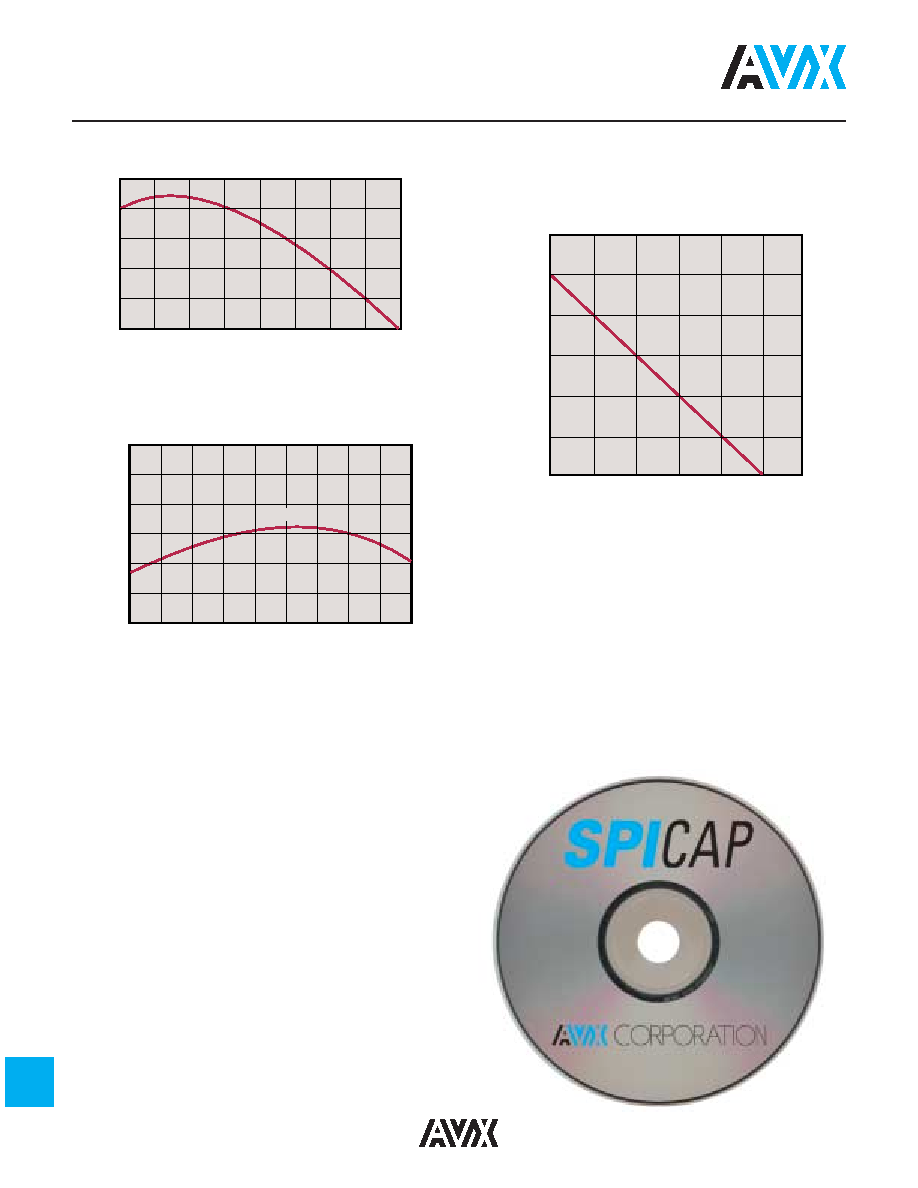- 您現(xiàn)在的位置:買賣IC網(wǎng) > PDF目錄24938 > 0805ZC103MA72A (AVX Corporation) General Specifications PDF資料下載
參數(shù)資料
| 型號(hào): | 0805ZC103MA72A |
| 廠商: | AVX Corporation |
| 英文描述: | General Specifications |
| 中文描述: | 一般規(guī)格 |
| 文件頁(yè)數(shù): | 6/20頁(yè) |
| 文件大?。?/td> | 338K |
| 代理商: | 0805ZC103MA72A |
第1頁(yè)第2頁(yè)第3頁(yè)第4頁(yè)第5頁(yè)當(dāng)前第6頁(yè)第7頁(yè)第8頁(yè)第9頁(yè)第10頁(yè)第11頁(yè)第12頁(yè)第13頁(yè)第14頁(yè)第15頁(yè)第16頁(yè)第17頁(yè)第18頁(yè)第19頁(yè)第20頁(yè)

54
General Description
Typical Cap. Change vs. D.C. Volts
X7R
Typical Cap. Change vs. Temperature
X7R
Effects of Time – Class 2 ceramic capacitors change
capacitance and dissipation factor with time as well as tem-
perature, voltage and frequency. This change with time is
known as aging. Aging is caused by a gradual re-alignment
of the crystalline structure of the ceramic and produces an
exponential loss in capacitance and decrease in dissipation
factor versus time. A typical curve of aging rate for semi-
stable ceramics is shown in Figure 6.
If a Class 2 ceramic capacitor that has been sitting on the
shelf for a period of time, is heated above its curie point,
(125°C for 4 hours or 150°C for 12 hour will suffice) the part
will de-age and return to its initial capacitance and dissi-
pation factor readings. Because the capacitance changes
rapidly, immediately after de-aging, the basic capacitance
measurements are normally referred to a time period some-
time after the de-aging process. Various manufacturers use
different time bases but the most popular one is one day
or twenty-four hours after “l(fā)ast heat.” Change in the aging
curve can be caused by the application of voltage and
other stresses. The possible changes in capacitance due to
de-aging by heating the unit explain why capacitance
changes are allowed after test, such as temperature cycling,
moisture resistance, etc., in MIL specs. The application of
high voltages such as dielectric withstanding voltages also
tends to de-age capacitors and is why re-reading of capaci-
tance after 12 or 24 hours is allowed in military specifica-
tions after dielectric strength tests have been performed.
Effects of Frequency – Frequency affects capacitance
and impedance characteristics of capacitors. This effect is
much more pronounced in high dielectric constant ceramic
formulation that is low K formulations. AVX’s SpiCap soft-
ware generates impedance, ESR, series inductance, series
resonant frequency and capacitance all as functions of
frequency, temperature and DC bias for standard chip sizes
and styles. It is available free from AVX and can be down-
loaded for free from AVX website: www.avxcorp.com.
25%
50%
75%
100%
Percent Rated Volts
Capacitance
Change
Percent
2.5
0
-2.5
-5
-7.5
-10
0VDC
-55 -35
-15
+5
+25 +45 +65 +85 +105 +125
Temperature Degrees Centigrade
Capacitance
Change
Percent
+20
+10
0
-10
-20
-30
Figure 4
Figure 5
1
10
100
1000 10,000 100,000
Hours
Capacitance
Change
Percent
+1.5
0
-1.5
-3.0
-4.5
-6.0
-7.5
Characteristic
Max. Aging Rate %/Decade
C0G (NP0)
X7R, X5R
Y5V
None
2
7
Figure 6
Typical Curve of Aging Rate
X7R
相關(guān)PDF資料 |
PDF描述 |
|---|---|
| 0805ZC103MA74A | General Specifications |
| 0805 | Case No. 0805 Device |
| 0805-T | Case No. 0805 Device |
| 0806-5400-01 | DOCSIS 2.0 Diplexer Filter |
| 0806-5400-03 | EuroDOCSIS 2.0 Diplexer Filter w/surge protection |
相關(guān)代理商/技術(shù)參數(shù) |
參數(shù)描述 |
|---|---|
| CP2101R | 功能描述:輸入/輸出控制器接口集成電路 USB to UART Bridge RoHS:否 制造商:Silicon Labs 產(chǎn)品: 輸入/輸出端數(shù)量: 工作電源電壓: 最大工作溫度:+ 85 C 最小工作溫度:- 40 C 安裝風(fēng)格:SMD/SMT 封裝 / 箱體:QFN-64 封裝:Tray |
| CP2102 | 功能描述:輸入/輸出控制器接口集成電路 USE 634-CP2102-GM RoHS:否 制造商:Silicon Labs 產(chǎn)品: 輸入/輸出端數(shù)量: 工作電源電壓: 最大工作溫度:+ 85 C 最小工作溫度:- 40 C 安裝風(fēng)格:SMD/SMT 封裝 / 箱體:QFN-64 封裝:Tray |
| CP2102EK | 功能描述:界面開發(fā)工具 for CP2102 Enhanced USB-UART Bridge Chip RoHS:否 制造商:Bourns 產(chǎn)品:Evaluation Boards 類型:RS-485 工具用于評(píng)估:ADM3485E 接口類型:RS-485 工作電源電壓:3.3 V |
| CP2102GM | 制造商:Silicon Laboratories Inc 功能描述: 制造商:SILLAB 功能描述: |
| CP2102-GM | 功能描述:輸入/輸出控制器接口集成電路 USB to UART Bdg Chip RoHS:否 制造商:Silicon Labs 產(chǎn)品: 輸入/輸出端數(shù)量: 工作電源電壓: 最大工作溫度:+ 85 C 最小工作溫度:- 40 C 安裝風(fēng)格:SMD/SMT 封裝 / 箱體:QFN-64 封裝:Tray |
發(fā)布緊急采購(gòu),3分鐘左右您將得到回復(fù)。